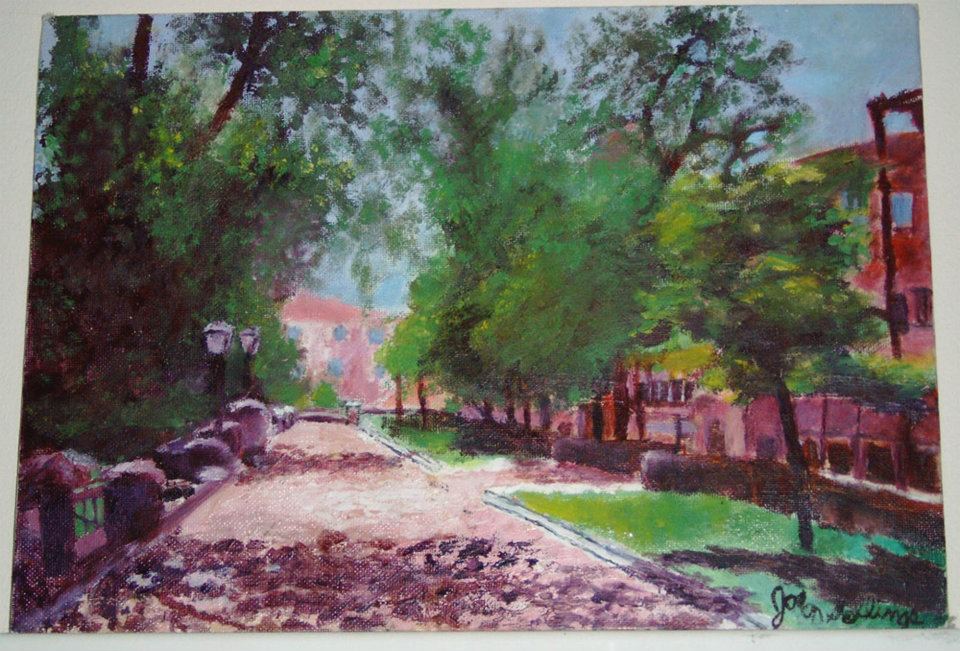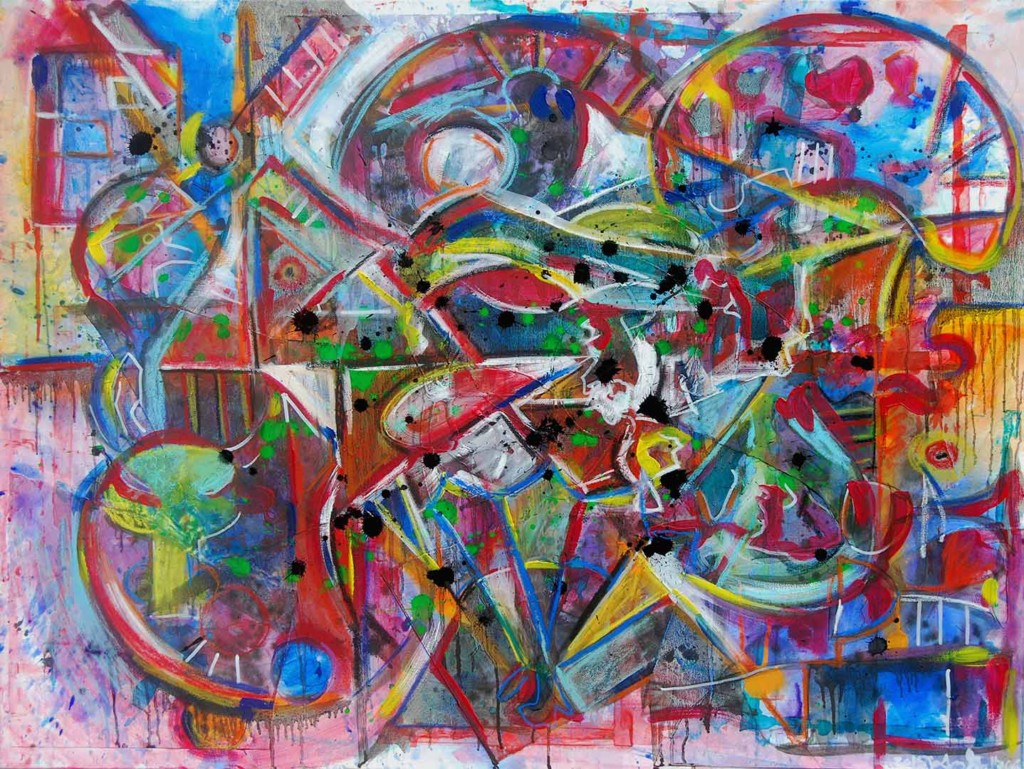My most recent artwork translates influences from Spanish art
My painting “Sketches of Spain” Translates influences from Spanish art. At first I sketched some ideas of your typical iconography: Bulls, flamenco fans, windmills from don Quixote, etc. I wanted to make this painting unique in its color with a deviation from standard colors. Lemon yellow, pthalo blue, and quinacridone red.
At a certain point I sought to move into a purely abstract direction. This was done knowing my next painting would be more figurative (the painting I created of Anthony Bourdain). There are some hints of these ideas that appear in the painting. Some more obvious than others.
I made a conscious decision to lean more into abstraction with this painting. Some icons get more “lost in abstraction” than other icons. The sketching process of this painting was a lot of fun, so expect to see more material from this painting in the future in one manner or another.
My first painting was taken from a photo I took when I studied in Spain
When I was 18, I traveled with a study abroad company called Learning Programs International. I visited the Prado, A castle filled with Goya paintings, as well as a Some other places I’ll discuss in a minute.
I had the fortunate pleasure of traveling to Madrid, Barcelona, Santander, Toledo, and Portugal. I lived in Salamanca and studied at the University of Salamanca. Here I would walk the same streets that influenced Miles Davis when he wrote his seminal album ‘Sketches of Spain.’ More on that in a minute.
Studying architecture and patterns from Southern Europe and North Africa
During my month in this program, I studied during the first part of the day, and the class I enjoyed the most was a program on architectural history. Here I really learned a great deal about Spain’s history. Influence from North Africa, the Middle East, and Europe put an indelible mark on the character of the nation’s culture and art. Here I would get exposed to the culture of Morocco and eventually the beautiful pattern designs of countries like Iran. The geometry of this part of the world can be truly beautiful.
Miles Davis exploration of Salamanca and the Sketches of Spain album
Miles Davis visited Salamanca, Spain, in 1960, where he was struck by the country’s vibrant culture and music. Inspired by the traditional Spanish music he heard, Davis began to incorporate these elements into his own unique jazz style, resulting in his iconic album “Sketches of Spain.” The album featured rich orchestration, intricate melodies, and traditional Spanish instruments, such as the guitar and the trumpet. “Sketches of Spain” was a critical and commercial success, cementing Davis’s place as one of the most innovative and influential musicians of the 20th century.
My interpretation of Sketches of Spain
Visiting La Sangrada Familia
During my time in Spain I visited La Basillica Sangrada Familia, Guell Park, and many other landmarks designed by visionary architect Antoni Gaudi. I was studying architectural histoy in a class at the University of Salamanca and the mix of middle eastern/North African, European, and contemporary influences made a major impression on me. The fact that
History of Gaudi and La Sangrada Familia
La Sagrada Familia is a basilica in Barcelona, Spain, designed by the renowned architect Antoni Gaudi. Construction began in 1882, but was halted in 1926 due to Gaudi’s death and the Spanish Civil War. The basilica has since been under construction for over a century, with ongoing work guided by Gaudi’s original plans and models. The unique design of the basilica blends Gothic and Art Nouveau styles, with towering spires and intricate sculptures that depict scenes from the Bible. La Sagrada Familia is widely regarded as Gaudi’s masterpiece, and has become an iconic symbol of Barcelona and Catalonia.
Gaudi’s approach to architecture was characterized by a deep respect for nature and a desire to integrate his designs into the natural world. He believed that architecture should be functional, but also beautiful and spiritually uplifting. His use of organic shapes, natural materials, and intricate ornamentation set him apart from other architects of his time. Gaudi’s approach to design was also highly collaborative, and he worked closely with craftsmen and artists to create every aspect of his buildings, from the overall structure to the smallest details. This unique approach can be seen in La Sagrada Familia, where every element of the design is carefully considered and intricately crafted, resulting in a truly awe-inspiring work of art.
Sangrada Familia is one of the longest running construction projects in modern history
The current projected completion date of La Sagrada Familia is 2026, which will mark the 100th anniversary of Antoni Gaudi’s death. However, it’s worth noting that the completion date has been pushed back several times in the past due to various factors, including funding issues and the complex nature of the construction process. Therefore, it’s possible that the actual completion date could be later than 2026.
Some of my favorite influences come from Spanish artists.
There is a whole list of Spanish artists that I have enjoyed for many Years. From Goya to Picasso, there’s a vast group of artistic wealth that Spain has produced.
Pablo Picasso is probably my favorite of all of these artists. There’s a fantastic TV series that was released in 2018 by National Geographic that covers not only his life, but how his art was created.
I recently got to see a collection of Dali’s Paintings at the Meadow’s museum
Dali’s “Poetics of the Small” is currently showing at the Meadows museum at SMU through December 9th.
I love Dali’s work because it both embodied and acted as an antithesis to certain aspects of Spanish painters. Where Picasso embodied the super serious machismo archetype of art in the country, Dali was fun and playful. There were certainly intense moments in his work, but it always invited the viewer into a fascinating world. There was always a slight wink and a nod in his artwork.
I visited just after the exhibit opened. These paintings were very small, but extremely detailed. It has inspired me to work a little smaller, and revisit icons and concepts from previous paintings.
There are many ideas in this new painting that may warrant re examination in smaller works.
Many paintings I have created in the past had great ideas that could use further iteration. I tend to pack a lot of ideas in my abstracts, and sometimes the visual interpretation of those ideas get pushed or pulled depending on what’s best for the painting overall, visually. This painting had some interesting concepts that I really want to explore in more detail. I want to elaborate upon them. I had a great drawing of a gestural representation of a flamenco dancer melded with a skeleton. Skulls and death imagery are very prominent in Spanish culture, especially given their countries history of revolution and war. There’s something really fascinating about the combination of a fascination between life and death that is so pertinent in Spanish history. I think ideas like this definitely deserve a second look.
This elaboration will also allow me to create works that can travel across the country. I have had a few conversations with representatives in other parts of the country as of late. However, transporting large works across the country is very expensive. So this may be a practical way to bridge that gap.
From here on out, I’ll move between abstraction, and figurative representation
I have ventured into figurative mixed media paintings recently. This doesn’t mean I am looking to abandon my abstract leanings entirely. This painting has been immediately preceded by a portrait of Anthony Bourdain, which you will get an update on next month. So from now moving forward, I will move between abstract and figurative painting to have a more dynamic creative output.
To conclude, I had a lot of fun venturing down memory lane with this painting. I look to explore culture and life around the world in future paintings. I have certainly done so in the past. Thanks for reading, and stay tuned for next month’s update!
-Jason



